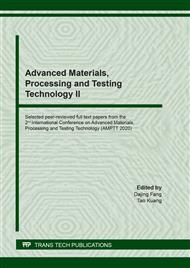[1]
Ma T Y, Dai S and Jaroniec M, et al. Metal-organic framework derived hybrid co3o4-carbon porous nanowire arrays as reversible oxygen evolution electrodes [J]. J. Am. Chem. Soc., 2014, 136:13925 - 13931.
DOI: 10.1021/ja5082553
Google Scholar
[2]
Zhang J T, Zhao Z H and Xia Z H, et al. A metal-free functional electro catalyst for oxygen reduction and oxygen evolution reactions [J]. Nat. Nanotechnology., 2015, 10: 444 - 452.
DOI: 10.1038/nnano.2015.48
Google Scholar
[3]
Chen Y, Ji S and Chen C, et al. Single-atom catalysts: synthetic strategies and electrochemical applications [J]. Joule, 2018, 2: 1242 - 1264.
DOI: 10.1016/j.joule.2018.06.019
Google Scholar
[4]
Wang Z Q, Huang W and Liu C, et al. Design of N-coordinated dual-metal sites: a stable and active Pt-free catalyst for acidic oxygen reduction reaction [J]. J. Am. Chem. Soc., 2017, 139: 17281 - 17284.
DOI: 10.1021/jacs.7b10385
Google Scholar
[5]
Zhao C, Dai X and Yao T, et al. Ionic exchange of metal–organic frameworks to access single nickel sites for efficient electro reduction of CO2 [J]. J. Am. Chem. Soc., 2017, 139: 8078 - 8081.
DOI: 10.1021/jacs.7b02736
Google Scholar
[6]
Cai S, Meng Z and Tang H, et al. 3D Co-N-doped hollow carbon spheres as excellent functional electro catalysts for oxygen reduction reaction and oxygen evolution reaction [J]. Appl. Catal. B Environ., 2017, 207: 477 - 484.
DOI: 10.1016/j.apcatb.2017.06.008
Google Scholar
[7]
Zhao S, Racemic B and Mustain W, et al. Highly durable and active Co3O4 Nan crystals supported on carbon nanotubes as functional electro catalysts in alkaline media [J]. Appl. Catal. B Environ., 2017, 203: 138 - 145.
DOI: 10.1016/j.apcatb.2016.09.048
Google Scholar
[8]
Li Z, Wang W and Cao H, et al. Boron doped ZIF-67@graphene derived carbon electro catalyst for highly efficient enzyme-free hydrogen peroxide biosensor [J]. Adv. Mater. Technol., 2017, 2: 1700224.
DOI: 10.1002/admt.201700224
Google Scholar
[9]
Zhang L L, Xiao J and Wang H Y, et al. Carbon-based electro catalysts for hydrogen and oxygen evolution reactions [J]. ACS Catal., 2017, 7: 7855 - 7865.
DOI: 10.1021/acscatal.7b02718
Google Scholar
[10]
Guan B Y, Yu L and Lou X W. A dual-metal–organic-framework derived electro catalyst for oxygen reduction [J]. Energy Environ. Sci., 2016, 9: 3092 - 3096.
DOI: 10.1039/c6ee02171a
Google Scholar
[11]
Tang C, Wang H F and Wang H S, et al. Guest–host modulation of multi-metallic (oxy) hydroxides for superb water oxidation [J]. J. Mater. Chem. A, 2016, 4 (9): 3210 - 3216.
DOI: 10.1039/c6ta00328a
Google Scholar
[12]
Di Chang, Xia Zhang, Qiong Liu, Ge GAO, and Yue Wu. Location based robust audio watermarking algorithm for social TV system., In Pacific-Rim Conference on Multimedia, pp.726-738. Springer, Berlin, Heidelberg, (2012).
DOI: 10.1007/978-3-642-34778-8_68
Google Scholar
[13]
Di Chang, Xia Zhang, and Yue Wu. A Multi-Source Steganography for Stereo Audio., Journal of Wuhan University (Natural Science Edition), 2013 (3): 277 - 284.
Google Scholar
[14]
Xia Zhang, Di Chang, and et al. An Audio Steganography Algorithm Based on Air-Channel Transmitting., Journal of Wuhan University (Natural Science Edition) 57, no. 6 (2011): 499 - 505.
Google Scholar
[15]
Xia Zhang, Di Chang, et al. Tree-like Dimensionality Reduction for Cancer-informatics., In IOP Conference Series: Materials Science and Engineering, vol. 490, no. 4, p.042028. IOP Publishing, (2019).
DOI: 10.1088/1757-899x/490/4/042028
Google Scholar
[16]
Rath P C, Patra J and Saikia D, et al. highly enhanced electrochemical performance of ultrafine CuO nanoparticles confined in ordered mesoporous carbons as anode materials for sodium-ion batteries [J]. J. Mater. Chem. A, 2016, 4: 14222 - 14233.
DOI: 10.1039/c6ta05238j
Google Scholar


